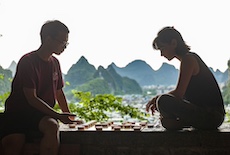What is the Chinese Calendar?
Learn Chinese in China or on Zoom and gain fluency in Chinese!
Join CLI and learn Chinese with your personal team of Mandarin teachers online or in person at the CLI Center in Guilin, China.
How much do you know about the traditional Chinese calendar? In this article, discover how the ancient Chinese lunisolar calendar works and learn about its relevance in modern-day China.

Image courtesy of Depositphotos
The traditional Chinese calendar
Modern China, like the vast majority of countries in the world, utilizes the Gregorian calendar—our standard solar-based calendar—as its primary means of tracking time throughout the year. That means January 1 in Paris is also January 1 in Beijing.
Yet as with so many cultural gems from Chinese history, the traditional Chinese lunisolar calendar—a distinct and separate timekeeping method from the aforementioned Gregorian calendar—has managed to secure its role in modern Chinese society.
To this day, the Chinese lunisolar calendar is used on a daily basis in China to track birthdays, Chinese holidays, and more.
Solar vs. Lunar vs. Lunisolar: What's the difference?
Often incorrectly referred to as a lunar calendar, the traditional Chinese calendar is in fact lunisolar. You may wonder, what's the difference between a strictly lunar calendar and the Chinese lunisolar calendar?
A lunar calendar is typically based on the moon's 29.53-day synodic orbit around the earth. The year is then divided into 12 lunar months, which inconveniently only adds up to 354 days per year, roughly 11 days short of the actual time it takes the earth to complete one full orbit around the sun: 365 days.
To remedy this discrepancy and to ensure that the traditional Chinese calendar keeps pace with the Gregorian calendar, the Chinese implemented the lunisolar method of timekeeping. The traditional Chinese lunisolar calendar is thus a hybrid timekeeping method that takes into account both the moon's orbit around the earth and the earth's 365-day orbit around the sun.
The Chinese accomplish this by adding a 13th month to their traditional calendar approximately once every three years. In Chinese, the Chinese lunisolar calendar is typically referred to as the 农历 (nóng lì), which directly translates to "agricultural calendar."

Chinese farmers traditionally used the Chinese calendar as a guide for planting and harvesting crops.
How does the Chinese calendar work?
Each month within the calendar starts with the new moon. The first month of the year is called 正月 (zhēng yuè) which marks the start of the new year cycle (and consequently the Chinese New Year celebration).
The Chinese calendar year ends with the last winter month which is called 腊月 (là yuè). Since 12 lunar months do not add up to a full solar year, a leap month (闰月 rùn yuè) is added every three years.
Days within a month are also grouped into 9 or 10-day weeks known as 旬 (xún). Each month is split into 上旬 (shàng xún), 中旬 (zhōng xún) and 下旬 (xià xún), marking the first, second and third week, respectively.
The Chinese lunisolar calendar operates on a sexagenary cycle (a 60-year cycle) which consists of 10 stems (干 gàn) and 12 branches (支 zhī). These are used to mark each month and year and in total can create 60 stem-branch combinations. Thus a 60-year cycle is formed, which figuratively was a full lifespan in dynastic times.

The Chinese lunisolar calendar operates on a 60-year cycle.
24 solar terms
There were originally only four solar terms in the Shang dynasty: the summer solstice, the winter solstice and the spring and autumn equinoxes. During the Han dynasty, however, the solar year (岁 suì) was further split into 24 solar terms known as 节气 (jié qì). These solar terms mark particular astronomical events such as equinoxes, solstices and other natural occurrences such as weather changes to guide farmers.
The 24 solar terms are as follows:
| Chinese | Pinyin | Significance |
|---|---|---|
| 立春 | lìchūn | start of spring |
| 雨水 | yǔshuǐ | rainwater |
| 惊蛰 | jīngzhé | awakening of insects |
| 春分 | chūnfēn | spring equinox |
| 清明 | qīngmíng | clear and bright |
| 谷雨 | gǔyǔ | grain rains |
| 立夏 | lìxià | start of summer |
| 小满 | xiǎomǎn | grain full |
| 芒种 | mángzhòng | grain in ear |
| 夏至 | xiàzhì | summer solstice |
| 小暑 | xiǎoshǔ | minor heat |
| 大暑 | Dàshǔ | major heat |
| 立秋 | lìqiū | start of autumn |
| 处暑 | Chùshǔ | limit of heat |
| 白露 | báilù | white dew |
| 秋分 | qiūfēn | autumnal equinox |
| 寒露 | hánlù | cold dew |
| 霜降 | shuāngjiàng | descent of frost |
| 立冬 | lìdōng | start of winter |
| 小雪 | xiǎoxuě | minor snow |
| 大雪 | dàxuě | major snow |
| 冬至 | dōngzhì | winter solstice |
| 小寒 | xiǎohán | minor cold |
| 大寒 | dàhán | major cold |
Is the Chinese calendar still used to this day?
The Gregorian calendar—the standard international calendar—is also the official calendar in China and used for all public and business affairs. This includes holidays such as Labor Day, Women’s Day, Chinese National Day, and the international New Year.
However, the Chinese calendar still plays an important and dominant role in everyday life. It is used to govern traditional Chinese holidays such as the Lantern Festival, Tomb-Sweeping Day (or Qingming Festival), Mid-Autumn Festival, and, of course, the Chinese New Year.

The Chinese calendar remains important in modern Chinese society, especially in rural areas.
Chinese astrology and fortune-telling
The stems and branches—both individually and in combination—also have Yin Yang and Wu Xing (five-element) attributes. Therefore, the Chinese lunisolar calendar is used in Chinese astrology and fortune-telling, for naming newborns, and for selecting auspicious days for weddings, funerals or starting a business/making a big purchase.
If curious, you can use this chart to find your own Chinese zodiac sign.

The Chinese calendar is intimately connected with the Chinese zodiac.
The Chinese calendar plays an integral part in modern Chinese society, both within China and the Chinese diaspora, so it is recommended to learn more if you are interested in further understanding the culture or if you wish to live in China.

Tania holds a BA in Arabic and Chinese from the University of Leeds, which led her to spend two years studying in Taiwan and Egypt as part of her degree. Her interests include Chinese traditional theater, international education, and programming. Tania travels to China annually and is fluent in Chinese.














